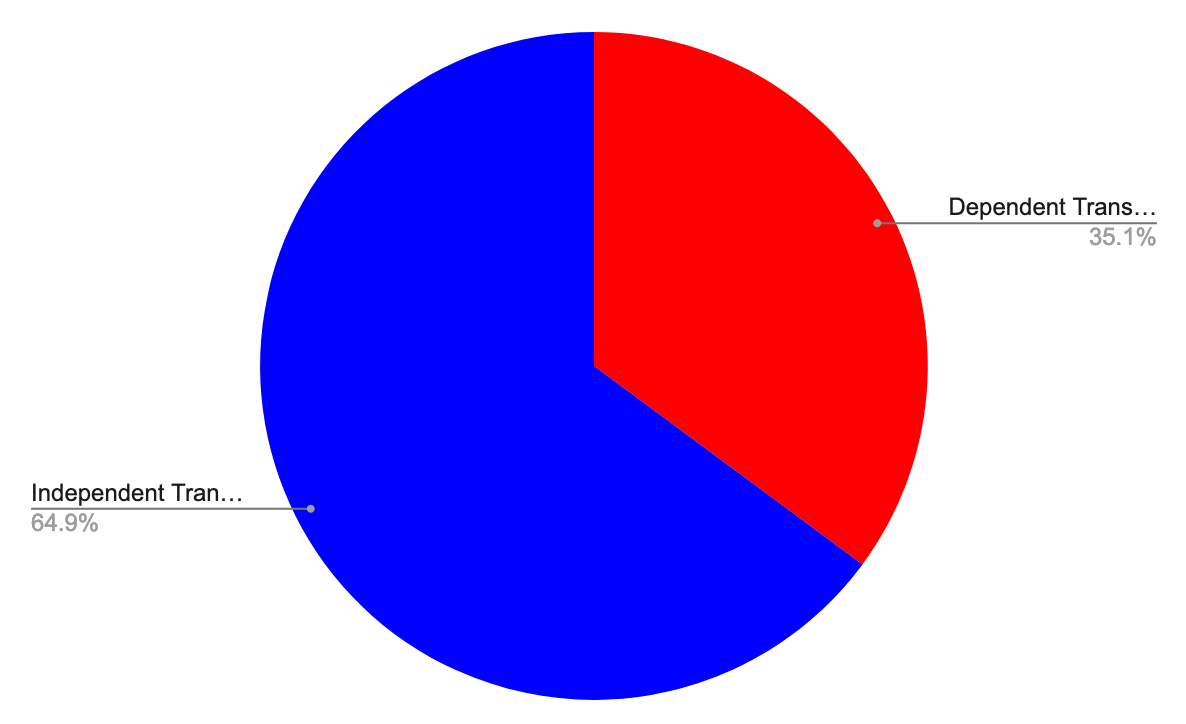64.85% of Ethereum Transactions Are Non-Dependent: What This Means for the Network’s Future
- Research shows 64.85% of Ethereum transactions can be processed independently, enabling potential parallel processing for higher throughput.
- Sequential processing limits Ethereum’s efficiency, but parallel transaction execution could reduce delays and improve scalability.
New findings by Sei, a layer-1 blockchain network, reveal that most transactions on Ethereum can be processed independently. The research suggests that 64.85% of Ethereum transactions are non-dependent, meaning they do not interact with or rely on other transactions in the same block.
This opens the possibility for Ethereum to implement parallel processing, a strategy that could increase transaction speed and throughput.
Currently, Ethereum handles transactions sequentially. This ensures transaction integrity but limits the network’s capacity to process high volumes efficiently.
Sequential processing means that even unrelated transactions, such as one user transferring 1 ETH to another while a separate user sends ETH to a third party, are queued rather than executed simultaneously.
The research also highlights that 35.15% of transactions remain0 dependent, requiring strict sequential execution to maintain consistency across the blockchain. Despite this limitation, the majority of Ethereum transactions could benefit from concurrent execution.
Sei proposes using optimistic concurrency control, a method where the network assumes no conflicts during processing and validates transactions after execution. This model is already employed within Sei’s infrastructure to improve scalability.
By adopting parallel processing , Ethereum could achieve faster block validation and reduce congestion during peak usage. This enhancement would not only boost transaction efficiency but also strengthen Ethereum’s position in the competitive blockchain landscape.
What This Means for Ethereum
The distinction between dependent transactions and independent transactions is critical for understanding Ethereum’s current transaction processing and its potential scalability improvements.
Dependent transactions interact with the same blockchain state, such as accessing the same address or modifying the same storage slots.
They also include scenarios where one transaction’s result is required for the execution of another. These dependencies mean transactions must execute sequentially to maintain the blockchain’s deterministic and consistent nature.
 Source: Blog SEI
Source: Blog SEI
For example, if a transaction credits a user’s balance and another deducts from it, the order of execution becomes essential. If processed out of sequence, errors such as insufficient funds may occur. This sequential processing creates bottlenecks in Ethereum’s throughput, as transactions must wait their turn, even if additional CPU cores are available.
In contrast, independent transactions do not interact with or modify the same blockchain state. These transactions can be executed simultaneously because their outcomes are unaffected by the order in which they are processed.
For instance, if Bob sends Alice 1 ETH and another user sends 1 ETH to a different address, these transactions are independent. Their execution paths do not overlap, making parallel processing feasible.
Adopting parallel processing could enable Ethereum to handle multiple transactions concurrently, significantly reducing delays and improving network performance. However, implementing this approach poses challenges.
Ethereum would need to adopt state access parallelization, which analyzes transactions for dependencies before execution. This method identifies independent transactions and schedules them for concurrent processing.
Blockchains like Solana and Sui already utilize this technique, combining it with localized fee markets to prevent congestion caused by high-demand contracts.
For Ethereum, parallel processing could resolve key inefficiencies. By enabling independent transactions to occupy unused block space, the network could mitigate congestion and reduce transaction fees during peak demand.
Ethereum is currently trading at $3,365.12 USD, experiencing a slight decline of 0.45% in the last 24 hours, but showing a 2.14% increase over the past week. The 24-hour price range spans from $3,354.44 to $3,410.29 USD.
Ethereum’s market capitalization is approximately $405,368,977,053 USD, solidifying its position as the second-largest cryptocurrency.
The 24-hour trading volume is $12,140,390,666 USD, reflecting a decrease of 27.80% compared to the previous day, which signals reduced trading activity.
Disclaimer: The content of this article solely reflects the author's opinion and does not represent the platform in any capacity. This article is not intended to serve as a reference for making investment decisions.
You may also like
ZKsync sunsets liquidity program amid bearish market
Watch these Bitcoin price levels as BTC retests key $84K resistance
Hyperliquid’s mystery 50x ETH whale is now betting on LINK
Navigating Crypto Volatility: How Bitcoin and Altcoins Influence Your Trading Choices
Understanding the Impact of Market Volatility on Crypto Trading: A Look at the Risk and Reward in Bitcoin and Altcoins

